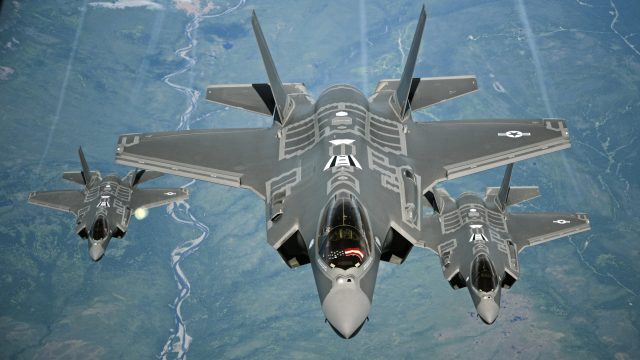Air Force grounds F-35A operations at training base after pilots suffered hypoxia

After pilots suffer "hypoxia-like symptoms," F-35As at one base are grounded
 US Air Force
US Air Force
The US Air Force's 56th Fighter Wing at Luke Air Force Base in Arizona today cancelled "local flying operations" for F-35A fighters after five incidents in which pilots "experienced hypoxia-like symptoms," an Air Force spokesperson said in a statement. Hypoxia is a deficiency in oxygen reaching the body through the circulatory system.
"In order to synchronize operations and maintenance efforts toward safe flying operations we have cancelled local F-35A flying," said 56th Fighter Wing commander Brigadier General Brook Leonard. "The Air Force takes these physiological incidents seriously, and our focus is on the safety and well-being of our pilots. We are taking the necessary steps to find the root cause of these incidents."
The cancellation of F-35A operations is currently restricted to Luke Air Force Base, the primary pilot training base for the F-35A. The Air Force also trains F-35A pilots at Eglin Air Force Base in Florida. The 56th Fighter Wing's squadrons at Luke train pilots from the US Air Force as well as from other nations buying the F-35A, including Norway, Italy, and Australia. All the pilots training at Luke will be briefed on the incidents and on the procedures the pilots affected used to successfully restore oxygen and land the aircraft safely, a 56th Fighter Wing spokesperson said. The 56th's Air Operations Group will also hold a forum with pilots to discuss their concerns.
According to an Air Force spokesperson, the F-35 Joint Program Office has "stood up a formal action team of engineers, maintainers, and aeromedical specialists to examine the incidents to better understand the issue. These subject matter experts will share the data across the F-35 enterprise and with partner nations."
There have been no previous groundings of the F-35 for life support issues, though there are other safety issues that have placed restrictions on pilots that have already been addressed. In May, the Air Force lifted weight restrictions on F-35 pilots that had been put in place because of a risk posed to lighter pilots by the aircraft's ejector seat system—it was shown in testing that the helmet F-35 pilots wore might break the necks of pilots under 136 pounds.
Hypoxia was previously a concern for the Air Force's F-22 Raptor. In July of 2012, the Air Force acknowledged that the F-22 was not delivering sufficient oxygen to pilots due to a collection of problems with pilots' life support gear. The Air Force Chief of Staff at the time, General Norton Schwartz, explained in a briefing in 2012 that the F-22's problem was partially due to the "upper pressure garment of the g-suit assembly"—the gear worn by the pilot to increase blood flow in the upper body and prevent blackouts. Another part of the problem "has to do with hose and valve and connection hardware in the cockpit," Schwartz had explained.
It's not as if this could be fixed by switching to President Trump's favorite fighter jet, either. The Navy and Marine Corps have also had pilot hypoxia problems with the F/A-18 Hornet and all its variants. There have been numerous and increasing issues with "physiological episodes," according to testimony submitted by the Navy to Congress in March. Bloomberg reported that a staff memo prepared for a March House Armed Services Committee hearing stated, “Since May 1, 2010, all models [of the F-18] show steady, yearly increases in the number of physiological episodes,” such as hypoxia and cabin decompression. And Navy officials told the committee that the problem was Navy aviation's “No.1 safety issue.”
-------------------------------------------
There are links in the Original article , by Sean Gallagher , Ars Technica
Tags
Who is online
36 visitors

Is that all you have to say?
What else is there to say?
We're watching a slow-motion train wreck that's going to cost zillions, while lowering our defense level. Everyone knows it, but so many palms have been greased that it cannot be stopped.
Sorry, I didn't see an image in your comment and thought it was blank. Now i see there is one but can't open it.
It's an angry emoji...
Thanks, Ryarios.
It's an over-sized emoji signifying crazy rage...
I worry about if we're trying to do too much too cheaply. I've had concerns from the beginning of the F-35 concept. Trying to make it work for everyone is very ambitious. I am worried it's too ambitious. It certainly was when they tried it with the F-111 and while that was years ago, I'm not sure technology has improved enough yet.
Anyway, I hope I'm proved wrong.